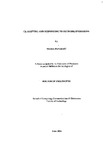CLASSIFYING AND RESPONDING TO NETWORK INTRUSIONS
| dc.contributor.author | PAPADAKI, MARIA | |
| dc.contributor.other | Faculty of Science and Engineering | en_US |
| dc.date.accessioned | 2013-09-17T13:01:39Z | |
| dc.date.available | 2013-09-17T13:01:39Z | |
| dc.date.issued | 2004 | |
| dc.identifier | NOT AVAILABLE | en_US |
| dc.identifier.uri | http://hdl.handle.net/10026.1/1814 | |
| dc.description.abstract |
Intrusion detection systems (IDS) have been widely adopted within the IT community, as passive monitoring tools that report security related problems to system administrators. However, the increasing number and evolving complexity of attacks, along with the growth and complexity of networking infrastructures, has led to overwhelming numbers of IDS alerts, which allow significantly smaller timeframe for a human to respond. The need for automated response is therefore very much evident. However, the adoption of such approaches has been constrained by practical limitations and administrators' consequent mistrust of systems' abilities to issue appropriate responses. The thesis presents a thorough analysis of the problem of intrusions, and identifies false alarms as the main obstacle to the adoption of automated response. A critical examination of existing automated response systems is provided, along with a discussion of why a new solution is needed. The thesis determines that, while the detection capabilities remain imperfect, the problem of false alarms cannot be eliminated. Automated response technology must take this into account, and instead focus upon avoiding the disruption of legitimate users and services in such scenarios. The overall aim of the research has therefore been to enhance the automated response process, by considering the context of an attack, and investigate and evaluate a means of making intelligent response decisions. The realisation of this objective has included the formulation of a response-oriented taxonomy of intrusions, which is used as a basis to systematically study intrusions and understand the threats detected by an IDS. From this foundation, a novel Flexible Automated and Intelligent Responder (FAIR) architecture has been designed, as the basis from which flexible and escalating levels of response are offered, according to the context of an attack. The thesis describes the design and operation of the architecture, focusing upon the contextual factors influencing the response process, and the way they are measured and assessed to formulate response decisions. The architecture is underpinned by the use of response policies which provide a means to reflect the changing needs and characteristics of organisations. The main concepts of the new architecture were validated via a proof-of-concept prototype system. A series of test scenarios were used to demonstrate how the context of an attack can influence the response decisions, and how the response policies can be customised and used to enable intelligent decisions. This helped to prove that the concept of flexible automated response is indeed viable, and that the research has provided a suitable contribution to knowledge in this important domain. | en_US |
| dc.language.iso | en | en_US |
| dc.publisher | University of Plymouth | en_US |
| dc.title | CLASSIFYING AND RESPONDING TO NETWORK INTRUSIONS | en_US |
| dc.type | Thesis | |
| plymouth.version | Full version | en_US |
| dc.identifier.doi | http://dx.doi.org/10.24382/4448 |
Files in this item
This item appears in the following Collection(s)
-
01 Research Theses Main Collection
Research Theses Main


